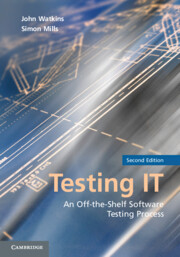Book contents
- Frontmatter
- Contents
- Foreword to the Second Edition by Geoff Thompson
- Foreword to the First Edition by Maurice Rosenburgh
- Acknowledgments
- 1 Introduction
- PART 1 THE TRADITIONAL TESTING PROCESS
- 2 An Overview of Testing
- 3 Testing Techniques
- 4 The Management and Planning of Testing
- 5 Unit Testing
- 6 Integration Testing
- 7 System Testing
- 8 Systems Integration Testing
- 9 User Acceptance Testing
- 10 Operations Acceptance Testing
- 11 Regression Testing
- 12 Improving the Testing Process
- 13 Introduction, Adoption, and Maintenance of the Testing Process
- 14 Agile Testing
- PART 2 THE TESTING PROCESS IN THE REAL WORLD: ILLUSTRATIVE CASE STUDIES
- PART 3 THE APPENDICES
- References
- Glossary
- Index
5 - Unit Testing
Published online by Cambridge University Press: 03 May 2011
- Frontmatter
- Contents
- Foreword to the Second Edition by Geoff Thompson
- Foreword to the First Edition by Maurice Rosenburgh
- Acknowledgments
- 1 Introduction
- PART 1 THE TRADITIONAL TESTING PROCESS
- 2 An Overview of Testing
- 3 Testing Techniques
- 4 The Management and Planning of Testing
- 5 Unit Testing
- 6 Integration Testing
- 7 System Testing
- 8 Systems Integration Testing
- 9 User Acceptance Testing
- 10 Operations Acceptance Testing
- 11 Regression Testing
- 12 Improving the Testing Process
- 13 Introduction, Adoption, and Maintenance of the Testing Process
- 14 Agile Testing
- PART 2 THE TESTING PROCESS IN THE REAL WORLD: ILLUSTRATIVE CASE STUDIES
- PART 3 THE APPENDICES
- References
- Glossary
- Index
Summary
“(The Programmer) personally defines the functional and performance specifications, designs the program, codes it, tests it, and writes its documentation … They need great talent, ten years experience and considerable systems and applications knowledge, whether in applied mathematics, business data handling, or whatever!”
– Fred P. BrooksOverview
The objective of unit testing is to ensure that reliable program units are produced that meet their requirements. The process is primarily intended to identify errors in program logic. Unit testing is conducted by the development team under the supervision of the development team leader. Typically, the software engineer or programmer who coded the unit will design and run a series of tests to verify that the unit meets its requirements. Unit testing may also be termed component testing.
Each unit should be tested individually and in isolation (although it may be necessary to employ a test harness) by exercising its inputs and observing its outputs. It may also be possible for the unit to be tested using the facilities available in the development environment (such as stepping through the statements of code using a debugger). Once confidence has been established in the unit, it should then be tested in collaboration with other interoperating units.
Unit testing is typically a white box testing activity, based primarily on the functional and data requirements expressed in the requirements specification for the application under test (AUT), as well as any supplementary material (such as design documentation, user guides, or prototype code).
- Type
- Chapter
- Information
- Testing ITAn Off-the-Shelf Software Testing Process, pp. 48 - 55Publisher: Cambridge University PressPrint publication year: 2010



